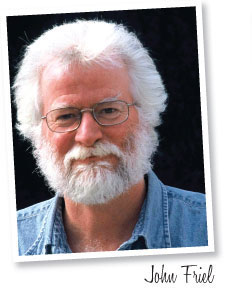1/1/2022
The Natives Are Priceless
John Friel

You can’t read many plant catalogs these days without encountering these words: “Native to North America.” Which is valuable information ... or is it?
The novelist John Barth wrote, “Nothing is intrinsically valuable ... value is assigned ... by people.” Jack London had a similar-sounding take: “Do you know the only value life has is what life puts on itself?”
As a gauge of which plants will suit a specific landscape or region, that catalog phrase (which I’ve certainly used) is only marginally helpful. It’s more an emotional trigger than useful growing information. North America encompasses every square mile from the Yukon to the Yucatan, from sea to shining sea, from the icy blasts of Nova Scotia to the sultry breezes of Key West and the muggy brackish backwaters of the Gulf Coast.
When discerning whether a given plant will work in your area, USDA hardiness zone info is infinitely more useful. Hardiness usually comes down to that plant’s native provenance vis-à-vis the place where you want to grow it. Think latitude: Where does its home turf lie, north-south, between the equator and the North Pole? Now think longitude: Picture where your patch of the world lies in a band circling the earth east-to-west. The flora that share your bandwidth, in North America, Europe or Asia, will have a pretty good shot at surviving your local conditions.
Admittedly, that’s painting the picture with a very broad brush. It leaves out an analogous swath in the other hemisphere, for starters. And your imaginary band has many a gap and wrinkle: rainfall, altitude, soil type and proximity to large bodies of water obviously complicate the equation and must be accounted for. But as a general indicator of whether your environment and a desired perennial are compatible, that familiar zone map is hard to beat.
So don’t read too much into that “native” statement as part of a plant description. Poison ivy (Toxicodendron radicans) is a North American native. So is stinging nettle (Urtica dioica), known as “burn hazel” where I live. Nettle has its uses; parts are edible. Organic growers make fungicide from it. Stinging nettle tea has been assigned value as a health supplement.
There’s even something to be said for poison ivy: Many birds including robins, quail and woodpeckers eat its berries. Insects including bees and butterflies feed on its flowers.
Is that valuable information? Maybe, marginally. If you walked into a garden center and found either plant in pots or in the aisles, you’d probably walk back out and someone would probably get fired. The value our industry has assigned to those species consists almost entirely of selling gardeners and landscapers the means to control them. And “control” is, of course, a euphemism for “kill.”
It feels, and often is, socially responsible to grow indigenous plants. You know why. Just as smokers can no longer convincingly argue that they didn’t know tobacco—another North American native, Nicotiana tabacum—is harmful to their heath, I think very few people in our industry don’t know why it’s good to grow natives. We’re constantly reminded that native plants restore habitat, support pollinators, help our beleaguered, vulnerable birds and, in short, maintain biodiversity.
I worry about our current collective attitude regarding natives and non-natives. We don’t need to choose one and spurn or denigrate the other. Please don’t overinterpret me: I’m an avid fan of North America’s magnificent flora. Aldo Leopold got it right when he said, “To keep every cog and wheel is the first precaution of intelligent tinkering.” Here’s some consolation: If you’re growing and selling a decent selection of perennials, in America or in Europe, you are a de facto grower and seller of American natives.
But I’m also strongly in agreement with Allen Lacy, who wrote, “The garden is a sort of United Nations, where plants from all over grow in perfect harmony.”
It feels crass to focus on the commercial aspect, but to the green industries, that emotional trigger is the main assigned value: Nativity is a reason to buy. It’s hard to have too many of those. GP
John Friel is marketing manager for Emerald Coast Growers and a freelance writer.